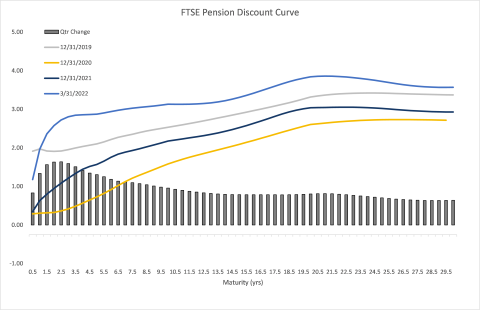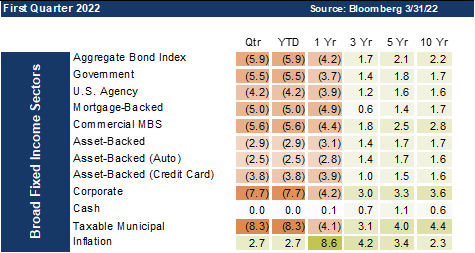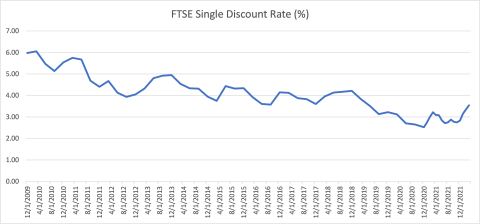Asset Liability Immunization Strategy (ALIS) Insights 2nd Quarter 2022 Outlook
Executive Summary:
- Pension discount rates continue to move higher following the movement in US Treasury bonds resulting in pension plans obtaining higher funding ratios.
- The impact of higher prices is beginning to influence the domestic economy causing the Federal reserve to take a more aggressive stance.
- Capital markets have responded by exhibiting mostly negative returns for the first quarter of 2022.
State of the Markets
In recent Insights editions, we often began by addressing the pandemic, although over the latest quarter, cases have fallen sharply and restrictions are being lifted at a precipitous rate, marking the beginning of the end to the pandemic. In its place, the war in Ukraine has shocked the world and resulted in further disruptions to already tormented supply chains, including the energy sector where prices have responded with strong upward volatility. Wheat, which is widely grown in Ukraine, has spiked higher in price leaving some to predict food shortages later this year. Fewer headwinds caused by the pandemic has allowed the economy to continue progressing toward fully reopening. Consumers are flush with cash and eager to resume a more normal existence, seeking travel, dining out, etc. Jobs are plentiful with openings around 11 million, coupled with very low unemployment, leading us to conclude anyone who wants to work, is working. There is a high correlation between a low unemployment rate and strong GDP, which we suspect will become more evident as the year moves on. The housing market remains out of balance with demand exceeding supply, leading to higher prices, and providing further evidence of inflation.
The biggest headwind for the economy in 2022 will be the developing restrictive monetary policy. The number of expected rate hikes seems to increase weekly as does the magnitude of each hike. The Fed raised the short-term interest rate by 25 basis points on March 16th. Many believe the next few rate hikes should be 50 basis points, if not 75 basis points, each. The market expects 210 basis points of additional rate increases by year end. Much has been written about an inverted yield curve. It’s an important indicator but in the past, it has given false signals that a recession was imminent. The main issue is when inflation will peak and how quickly it will decline. Until there is evidence that inflation is under control, expect the capital market to assume additional rate hikes are forthcoming.
Pension Plan Index Update
2022 has started with a significant rise in interest rates. The 2-year maturity Treasury yield has increased 160 basis points. The five-year Treasury yield has risen 120 basis points and the 30-year Treasury is up 54 basis points higher than on 12/31/21. From a total return standpoint, the bond market had its worst quarter in over 40 years, evidenced by the Bloomberg Aggregate Bond Index which fell 6.0% for the quarter. An index comprised of U.S. Treasury securities and high-grade corporate bonds with a 5-year maximum maturity declined 3.5% for the 1st quarter.
Following the rate movements seen in the US Treasury market, pension discount rates rose sharply, flattening the curve in the first quarter. Once again, it was the short end that demonstrated the largest degree of change. On average across the maturity curve spectrum, rates improved 92 basis points, whereas the single rate increased 71 basis points over the quarter. Rising discounts rates continue to have a positive effect on many plans’ funding ratios. Our expectation of a reversal in the single rate trend of modestly lower lows, has been confirmed.
The lows reached in November of 2020, now measure over 100 basis points higher. Several pension funding indices now measure the average plan’s funded status in the area of 95-105% funded, levels not seen since before the 2008 financial crisis, on average an improvement from 1-3% since year end. This presents an opportunity for plan committees to protect their progress by de-risking and/or hedging their plans and in turn stabilizing their funded ratios.
Fixed-Income returns were uniformly negative over the quarter as the market priced in the effects of a Fed determined to address higher inflation expectations. The first quarter also saw the third highest quarterly corporate bond issuance since Bloomberg began keeping records which perhaps speaks to corporations’ outlook on the opportunity cost of where interest rates are heading.
In a similar fashion to bond returns, equity returns for the quarter exhibited negative performance across the various indices. On a 12-month basis, areas of increased equity risk underperformed with domestic large cap stocks exhibiting the most positive returns. Value stocks continue their recent trend of outperforming growth. These effects can all be attributed to the aforementioned geopolitical turbulence, somewhat high historical valuations, and the confidence in future economic growth.
Economic Outlook
Last quarter we discussed in detail how the Fed would raise short term yields and that as the Fed walked away from bond purchases, along with technical and behavioral reasons, there was tinder to drive yields higher in 2022. We have also been operating under a theme that some of the most painful sources of inflation (food, shelter, transportation, and fuel) would be less than transitory. It seemed as if the gravitational force of price increases, absent similar wage gains, would pull growth expectations down to earth because of the resulting demand destruction. New home sales may be signaling that some of our expectations are coming to fruition. As 30-year mortgage rates have risen nearly 150 basis points, exceeding 5%, the pace of new home sales has declined in both January and February. The combination of recent dramatic housing price increases and the heightened cost to finance a home has placed home ownership out of reach for many Americans. It is a meaningful example of how price increases impact demand and consumer behavior. We anticipate the materialization of many more examples of changing consumer habits as the year progresses.
Last quarter we expected the Fed would raise rates in May, then they demonstrated they are far more nimble than past Feds, by stopping QE and hiking within the month of March. The Fed communicated to the market that they were going to get after the problem of inflation faster than many expected was possible. As a result, the market shock translated into sharp and eye-popping fixed income market losses. That is to suggest much of the cumulative pain may be behind us.
The perceptive themes we introduced last quarter involved an inverted yield curve, quantitative tightening, sources of inflation persisting at a pace faster than wage growth, devalued human capital, a retail centric municipal market sell-off, and that 10-year high-quality municipal bond yields would hit 2.20% (they started the year at 1.05% and hit a peak of 2.26% before closing the quarter at 2.23%). According to Bloomberg, their Treasury Index experienced a loss of roughly 5%, which going back to 1990, has only happened 4 times. The study suggests that losses of this magnitude represent a rare 2.5 standard deviation event. As believers in mean-reversion, the expectation that experience tends to return to long-term normal relationships, we forecast that over the next year or two, bonds will broadly experience above average returns from this point. By some measures, you have lived through one of the worst bond markets since the mid-1970’s. We think there will be reward for being on the other side of this event.
We must admit the financial news coverage addressing whether the inversion was a fraction of a basis point, or a commanding handful of basis points has been gripping. Some will say that it is a poor indicator of recessions and others believe with the intensity of 1,000 suns that a recession is now a foregone conclusion. The real reflection is whether cause or correlation is the relationship between inversions and recessions. The unsatisfactory answer is that at times it may be causal and other times it may be correlation.
"Our suggestion is to be aware of curve inversions and study the past behavior of various asset classes around the time of inversions and recessions but..."
Our suggestion is to be aware of curve inversions and study the past behavior of various asset classes around the time of inversions and recessions but understand that central banks around the world have manipulated markets since at least 2008. This has been a nimble Fed and if a need to adjust the yield curve presents itself, while making progress on the dual mandate of full employment and price stability, asset sales are a possibility, we expect outright asset sales could quickly sober up markets and dampen the faint animal spirits in the market. In truth, this doesn’t seem like an animal spirits-driven inflationary episode, it feels like a hesitant bottleneck laden economy with zombie companies and consumers being propped up by cheap borrowing and a deluge of stimulus cash. While curve shape is certainly worth noting, curve consequences are the indicator we will be watching.
There will likely be consequences to the removal of cheap short-term borrowing costs, challenges with a flatter yield curve, and economic headwinds caused by the recent increase in longer-term borrowing rates. Rising short-term borrowing will likely drag on consumers and high-yield corporate borrowers. Prior to the start of Fed rate hikes, at the end of 2021, consumer debt service payments for financial obligations as a percent of disposable income rose at the fastest pace since 1980. Zombie companies are afforded the luxury of remaining undead due to modest risk spreads and artificially low short rates. As input and operating costs put pressure on margins, some of these companies will likely fail or be acquired. A flat curve creates challenges for traditional financial institutions as they source funds in the short part of the yield curve and lend or buy investments farther along the curve. The misery of these groups, along with the interplay among them, may determine if an elusive “soft landing” can be engineered by the Fed, or if a recession falls upon us.
A key barometer of where the economy is headed will be the labor market. Analysis of the unemployment rate, sectors of wage growth persistence, and where job openings remain and evaporate will add predictive value into the likelihood of a recession. Chair Powell has indicated the employment environment is too tight. If inflation collides with widely felt economic uncertainty, the unemployment rate could climb. An indicator of recessions, developed by Federal Reserve economist Claudia Sahm, The Sahm Recession Indicator, says that if the three-month moving average of national unemployment rises by .5% or more, relative to its low during the previous year, a recession is underway. Note it is not a predictive indicator, rather, it tends to identify early in a recession that you are in a recession. If the unemployment rate increases by 2%, it is expected a deep recession is upon you. As rising costs take their toll on people, we can envision consumers reducing dinners out, canceling trips, and reducing transportation expenses. The consumer discretionary area, including hospitality and service industries, could be poised for job losses once again.
We anticipate that 10-year Treasury yields will flirt with something close to 3% in the second quarter, before heading lower as the year ends. The Fed raises rates to slow the economy down. They have been clear in their resolve to wring the inflation feedback loop out of the economy, and the employment environment is so tight, they can introduce more discomfort than previously thought to achieve their goals. We continue to expect the volatility and yield updrafts of the second quarter will represent the bond market buying opportunity of the year.
"Our synthesis of this information is that you can choose to trade this market, or you can get your house in order for a failed soft landing that will likely turn to an uncomfortable recession."
Past performance is not a guarantee of future results. The statement is so prevalent that it almost discourages practitioners from synthesizing information gleaned from past market events to inform current strategy and communicate our expectations. Here are some nuggets we’ve uncovered. April tends to be a strong month for stock market performance, but the second quarter of the year of a midterm election seems to be the most dangerous of all the quarters of a Presidential term. Following a curve inversion, but before a recession, historically both stocks and bonds experience above average returns. As measured from the start of a 2-year Treasury versus 10-year Treasury inversion through the following 12 months, long government bonds and high-quality corporate issuers and sectors tend to do materially better than more volatile sectors of the corporate bond market, lower-rated issuers, and short Treasuries (all based on averages experienced during the past five inversions). Our synthesis of this information is that you can choose to trade this market, or you can get your house in order for a failed soft landing that will likely turn to an uncomfortable recession.
In the context of the Fed slamming on the breaks with Fed Funds hikes and QT, along with the global sources of fiscal stimulus tapering off dramatically, it certainly seems that Q2 of 2022 will be a bumpy ride as people realize the “party” will have to be over for inflation to be snuffed out. To be safe, we will say that risk assets will see meaningful volatility, but it seems that broadly bonds will see more discomfort and stocks should see additional losses. As stagflationary pain turns to expectations for a recession, the fear of a looming recession will cause stocks to find a bottom coinciding with high-quality bonds exhibiting price gains. In stark contrast, high-yield, and risky corporate sectors may not take the same ride.
We don’t anticipate an eventual soft landing. Prepare to brace for impact.
Investment advisory services are offered through Advanced Capital Group (“ACG”), an SEC registered investment adviser. The information provided herein is intended to be informative in nature and not intended to be advice relative to any specific investment or portfolio offered through ACG. The views expressed in this commentary reflect the opinion of the presenter based on data available as of the date this was written and is subject to change without notice. Information used is from sources deemed to be reliable. ACG is not liable for errors from these third sources. This commentary is not a complete analysis of any sector, industry, or security. The information provided in this commentary is not a solicitation for the investment management services of ACG and is for educational purposes only. References to specific securities are solely for illustration and education relative to the market and related commentary. Individual investors should consult with their financial advisor before implementing changes in their portfolio based on opinions expressed.





